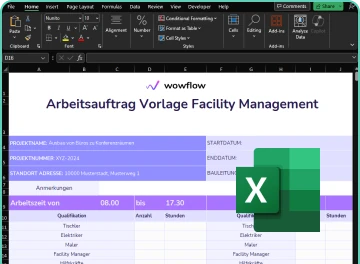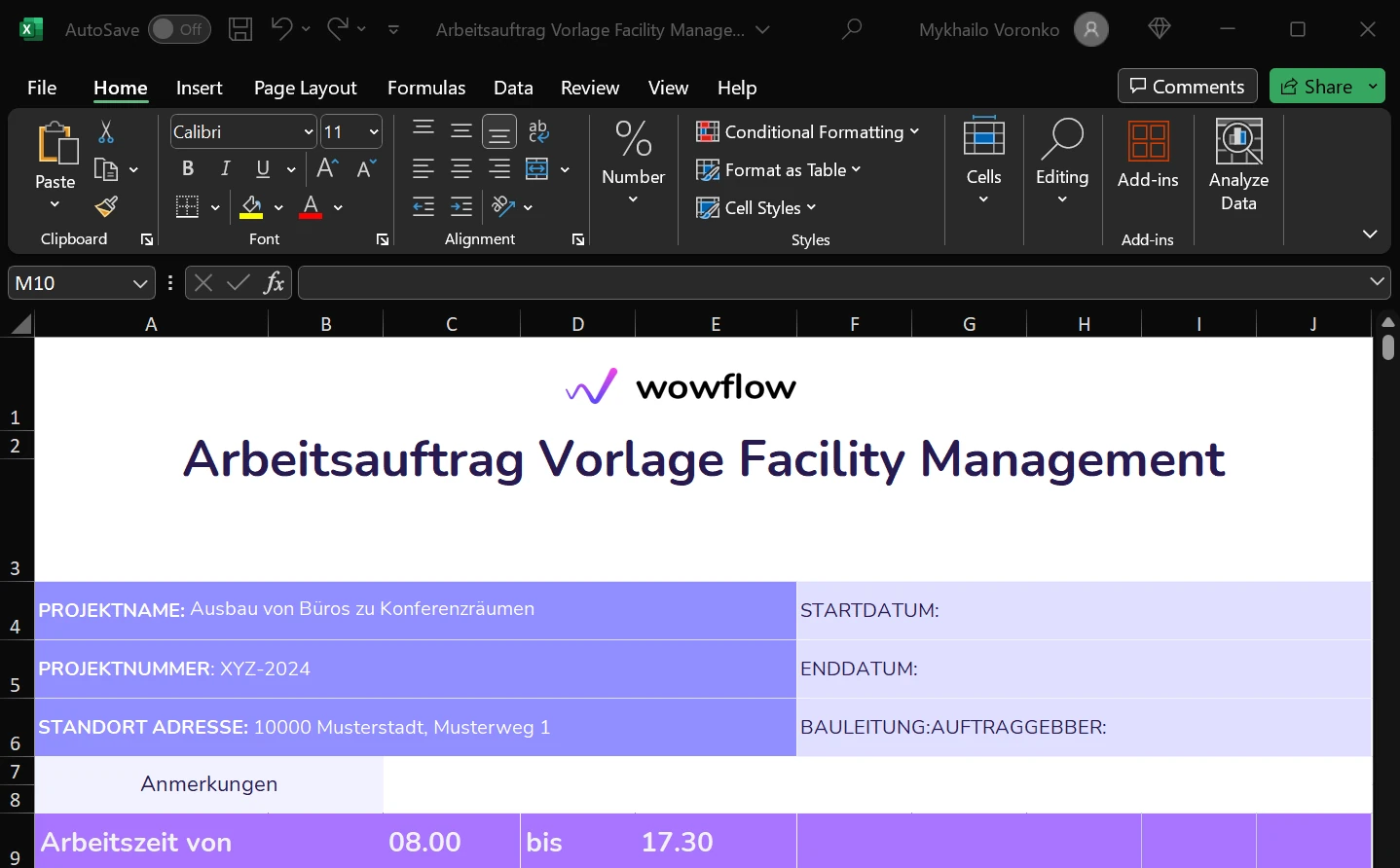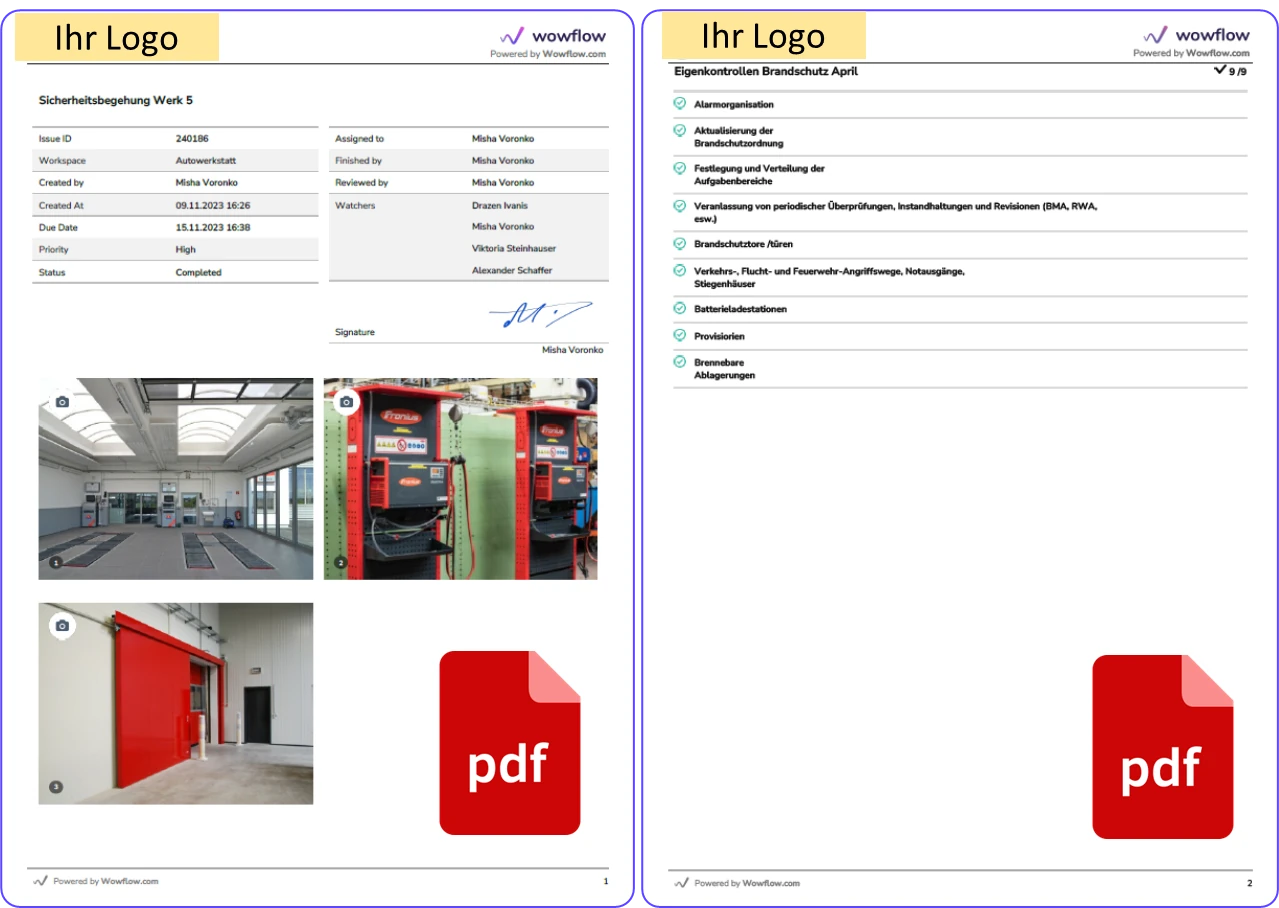
Simplify your workflows and maximize your company’s efficiency with our free work order templates.
Read our article to find out how you can benefit from the introduction of work order templates.
Download our practical templates and discover how they can help you achieve your goals more effectively.
Work order: definition and purpose

By definition, a work order is a request to one or more people to complete certain tasks.
In practice, work orders are used to delegate maintenance, repairs or other work specifically to people or groups with the required knowledge and skills.
A task can be communicated verbally, in writing or digitally. Work orders look very different depending on the industry, requirements, size of the company and the technology used to create them.
The creation, processing and management of orders, including the choice of software, are all part of order management.
The purpose of a work order is to provide clear information about the work to be performed, along with the data required to perform, track, update and sometimes calculate these tasks.
In work order management, clear structuring of the order is crucial to avoid misunderstandings and ensure efficient execution of tasks.
The work order template is a useful tool for organizing and structuring orders.
It serves as a guide for employees to understand and implement the necessary steps and objectives of a project. The use of such a template in facilities management supports communication between maintenance teams, thus ensuring efficient and coordinated workflows.
- A work order is a request in which certain tasks are delegated to one or more people.
- A work order template is an organizational tool for structuring and standardizing work processes.
- Choosing the right work order management software and effective order management are essential components of successful order implementation.
6 Advantages of a work order template

Templates for work orders offer numerous advantages. We have listed the six most important advantages for you below.
1. Standardization:
The template ensures a standardized procedure when creating a work order and contributes to uniformity within the company.
2. Time saving:
Using a template eliminates the need to create work orders from scratch each time, saving time and enabling faster implementation.

3. Error reduction:
A well-designed template minimizes the risk of errors and incomplete information in orders, resulting in fewer rework and higher quality work.
4. Clear communication:
The template ensures that tasks and requirements are communicated uniformly and clearly.
5. Increase in efficiency:
Familiarity with the template enables employees to quickly familiarize themselves with the workflow and complete tasks efficiently.
6. Tracking and management:
Important information such as priorities, deadlines and responsibilities can be recorded in the template, making it easier to track and manage tasks.
7 main types of work orders

A company usually requires several types of work orders for its servicing work. Depending on the size of the company and the industry, certain types of orders are used more frequently than others.
For example, there are far more safety orders in a company that manufactures hazardous chemicals than in an apartment complex. Get to know the 7 most important types of orders now.
1. Orders for maintenance:
Maintenance orders are used to rectify problems with a system that a technician has discovered during an inspection or other work.
As a rule, these work orders involve the repair or replacement of appliances or appliance parts. Predictive maintenance orders differ from emergency orders where the equipment or system has already failed.
2. Emergency order:
A company places an emergency order if a critical system or device has failed and is causing production and/or safety problems. They require immediate action and therefore have the highest priority.
3. General order:

General work orders are used for a wide range of non-urgent services. These do not belong to any specific category, such as everyday work or minor repairs in buildings (replacing broken lamps or door locks).
4. Inspection order:
A company must have its systems inspected regularly.
As part of recurring and/or predictive maintenance programs, a company commissions a test (or series of tests) to evaluate the performance of an asset to proactively identify anomalies, risks and other functional issues.
In building management, the fire alarm system and smoke detectors must undergo an annual functional test. To this end, the facility management team issues a work order to a certified specialist company.
- Fire protection documentation: Recording and management of information relevant to fire protection.
5. Work orders for preventive maintenance:
A preventive maintenance work order allows an organization to schedule routine work to maintain the optimal functioning of its facilities and extend the life cycle of its equipment. The cleaning of systems is one of these measures.
Maintenance logs are important tools for carrying out your maintenance jobs in the best possible way.
You can find further templates and checklists for maintenance in our
Preventive maintenance contracts also help companies to reduce the downtime of their systems, fulfill their operator responsibility and reduce the costs associated with major repairs.

6. Safety order:
In contrast to other types of orders, security orders serve exclusively to protect people from harm or danger.
Safety orders involve repairs that prevent personal injury, such as retrofitting protective caps to radiators and pipes to prevent the risk of scalding.
7. Special project order:
Special project orders focus on upgrades and improvements. These orders enable companies to install new equipment that helps to modernize facilities and increase productivity.
Sustainability aspects, for example, are taken into account in building management.
- Sustainability real estate: Integrating environmentally friendly practices into real estate processes.
- Sustainability cleaning: Implementation of sustainable cleaning methods and products.
Our free Excel work order templates

Our work order templates will help you with any type of work order. Our templates are optimally structured and provide clear instructions so that you can carry out every job smoothly.
Download our work order templates in Excel format now.
Create your orders effortlessly with a digital solution
Digital solutions for orders offer an efficient and user-friendly method of creating and managing orders.
- With Wowflow’s order management software, you can easily generate professional work reports in comprehensive PDFs that include all relevant images, data and signatures. You can send your reports to the customer in no time at all with our app.
- Manage all orders in one place. By integrating e-mails, you no longer waste time searching for individual information.
- With our app, you can delegate work to facility management teams or external service providers with just a few clicks.
Experience the efficiency and benefits of Wowflow for yourself and optimize your work orders today!
Conclusion
Work order templates offer an effective solution for organizing and structuring tasks in different work areas. They facilitate communication, optimize efficiency and promote a coordinated way of working.
By clearly structuring and standardizing the execution of work orders, companies can save time and improve the quality of their work results.
The use of a digital order management solution such as Wowflow brings additional benefits such as automation options that lead to faster and more precise order processing.
Frequently asked questions
Who may issue work orders?
Work orders can be issued by facility managers, maintenance teams or other authorized persons within an organization, depending on the defined responsibilities and hierarchies.
What is the difference between a project and a work order?
A project usually refers to larger plans such as the implementation of a maintenance program for the entire company. Work assignments, on the other hand, relate to specific tasks.
In asset management it is, for example, the inspection of a specific room or the repair of a system.
How do you formulate a work order?
A work order should contain clear instructions for carrying out the task, such as a precise description of the maintenance or repair work, details of priority, specific deadlines and responsibilities for execution. The precise description of the task and clear instructions help to ensure a smooth and efficient process.




